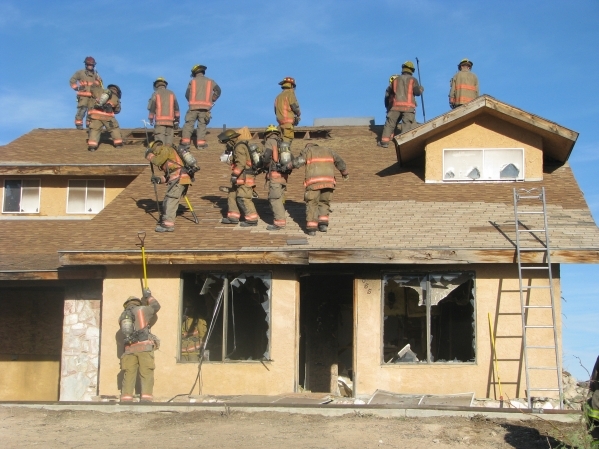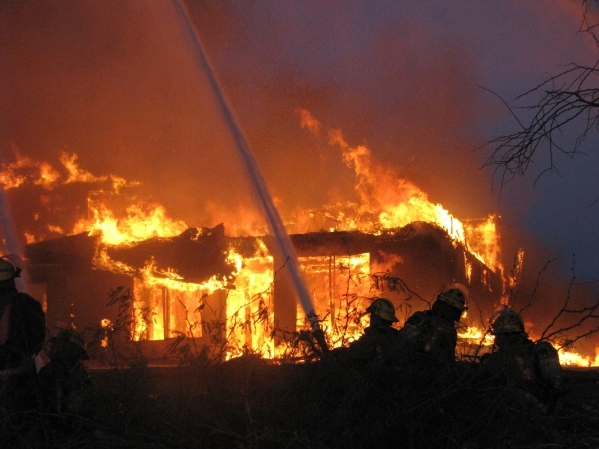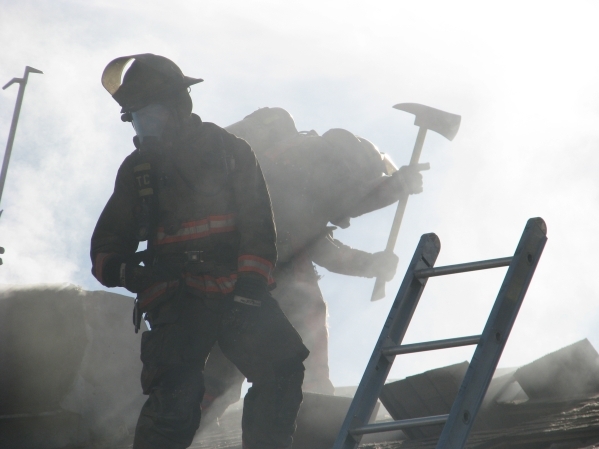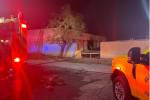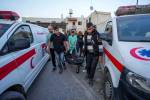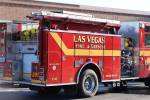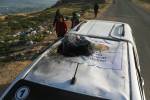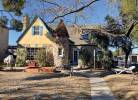Firefighter training involves multiple stages
Dozens of firefighters stood just a few feet away from a rural Moapa home in the fading light of a beautiful, crisp November day and did not put out the growing fire. Instead, they posed for pictures, joked among themselves and made educated guesses on which part of the house would collapse next.
They had already put out the fire a dozen times on Nov. 20. The house had been donated for training, and the group of firefighters and trainees had spent the day at the house, alternately setting it on fire and putting it out. They had spent the previous day preparing it for the repeated burns.
"There's double sheetrock in all of the rooms with fire," said Parker Simper of the Clark County Fire Department. "The upstairs is blocked off with sheetrock to keep the smoke from traveling between floors, so that if something goes wrong below, it won't affect the training on the roof."
Normally, much of the 20-week firefighter training takes place at the Clark County Fire Department Training Center, 4425 W. Tropicana Ave., but this was an an unusual training session.
"We got lucky with the Riviera this time around and did a lot of training there," said Gary Stevenson, training chief at the center. "We're 18 weeks into the program, and we have the great opportunity to train at this house."
The house was ideal for the training, located several hundred feet off of the road and isolated from surrounding structures but still close enough that water lines could reach it. The two-story, 3,000-square-foot home had not been occupied for many years, and vandals had made it unfeasible to repair for habitation, but it was mostly intact. The owners had bought the land sight unseen and were surprised when they received trash and water bills. They had no idea they had purchased a derelict home along with the 9 acres of property.
The two-pronged training session consisted of one group prying open a door on the first floor where a stack of pallets was burning while a second group practiced properly setting and climbing a ladder and cutting holes in the roof. The downstairs crew was practicing their hose-carrying and fire-extinguishing skills. The upstairs crew was using a chainsaw and a Denver or Colorado Hook, a long, hooked tool, to vent the room below.
"We have a room at the training center where we do flashover training," Stevenson said. "Flashover is a condition where all the contents of the room reach combustion temperature, and everything from floor to ceiling ignites at once. Cutting a hole in the roof allows the superheated gases and smoke to evacuate."
At the training center, a two-leveled room is used to show the conditions that lead to flashover so that firefighters recognize when there is still time to do something and when to get out. Temperatures in a flashover can reach 1,100 degrees, and the equipment and protective gear the fire department uses is rated to withstand a temperature of 500 degrees for a few seconds. Beyond that, firefighters will experience what Stevenson referred to as "thermal compromise." In the flashover room at the center, trainees sit 4 feet below the room to observe the conditions safely.
"This training exercise here has been useful for a lot of reasons," Stevenson said. "For instance, to vent the roof, they have to cut through it with the chainsaw and axe and then break through the sheetrock ceiling with the hook. In the training center, the distance between the roof and the ceiling is only about a foot. In this particular structure, the distance is closer to 6 feet. They're also finding out that the plastered and painted sheetrock is harder to break through than what we've used in the training center."
The house also provided an opportunity to show how effective venting the roof is. More than 40 firefighters and trainees waited in a smoke-filled room to witness the effect firsthand as others cut through the roof.
The firefighters spend 20 weeks learning how to carry hoses efficiently and safely; how to operate equipment, such as chainsaws; how to put on their gear properly; and how to maintain all of the equipment. In addition to firefighting, some also receive EMT training. The department uses the buildings of several businesses near the training center to practice ladder and hose work in a variety of situations.
At the end of the day, the house was heavily ventilated, and flammable material was piled inside. From ignition to being fully involved took about 15 minutes, but the house was still burning hours later while firefighters and trainees watched and studied.
The Clark County Fire Department and the fire departments of Henderson, North Las Vegas, Mesquite, Mount Charleston and Pahrump are having a recruitment drive. Information about minimum qualifications for each agency, testing dates and other pertinent information about the recruitment effort is available at snvfirerecruitment.com.
Applications will be accepted online only through the website. The number of applicants will be limited to the first 4,500 who apply online, and the application period will close Dec. 22 or when the first 4,500 applications are received. Applicants also will be required to take a written exam and pass a physical abilities test called the Candidate Physical Ability Test, or CPAT. The CPAT can be taken locally at the College of Southern Nevada. Visit csn.edu/cpat.
To see a video of the Moapa burn training exercise, visit viewnews.com.
— To reach East Valley View reporter F. Andrew Taylor, email ataylor@viewnews.com or call 702-380-4532.
Recruitment drive
The Clark County Fire Department and the fire departments of Henderson, North Las Vegas, Mesquite, Mount Charleston and Pahrump are having a recruitment drive. Information about minimum qualifications for each agency, testing dates and other pertinent information about the recruitment effort is available at snvfirerecruitment.com



